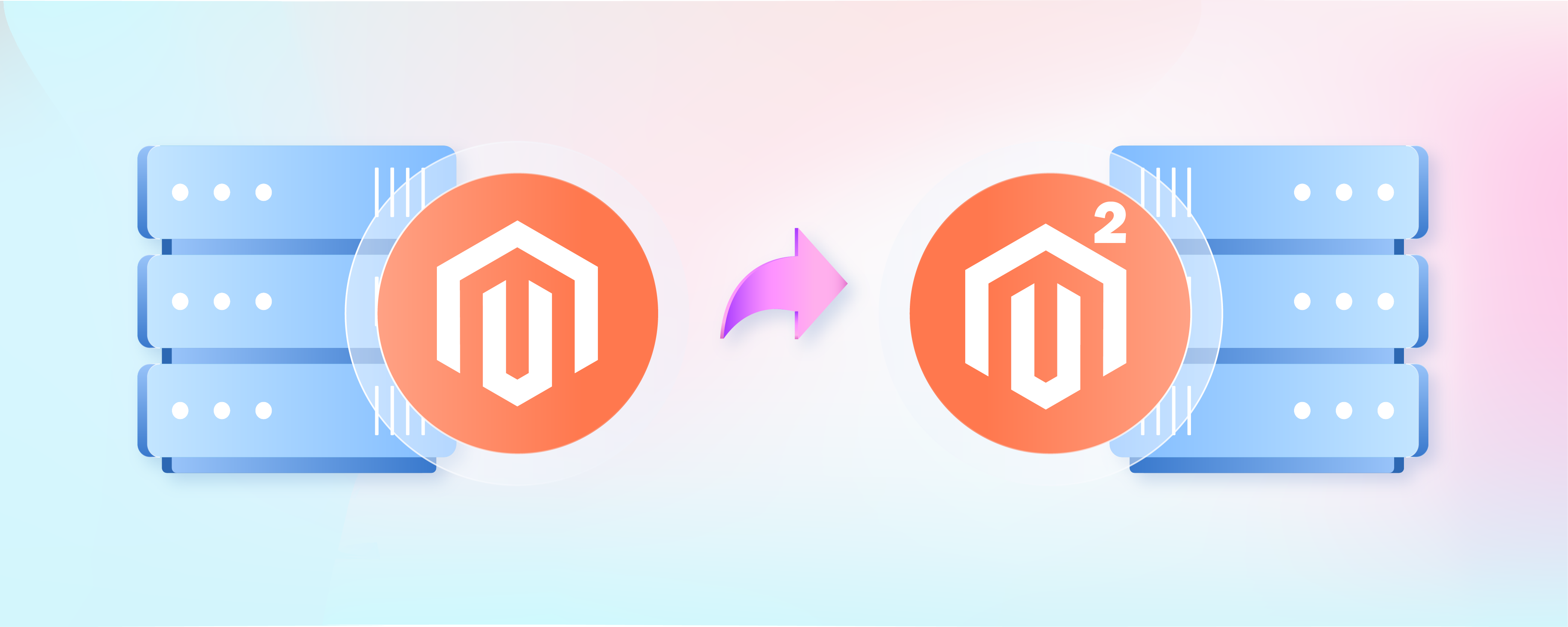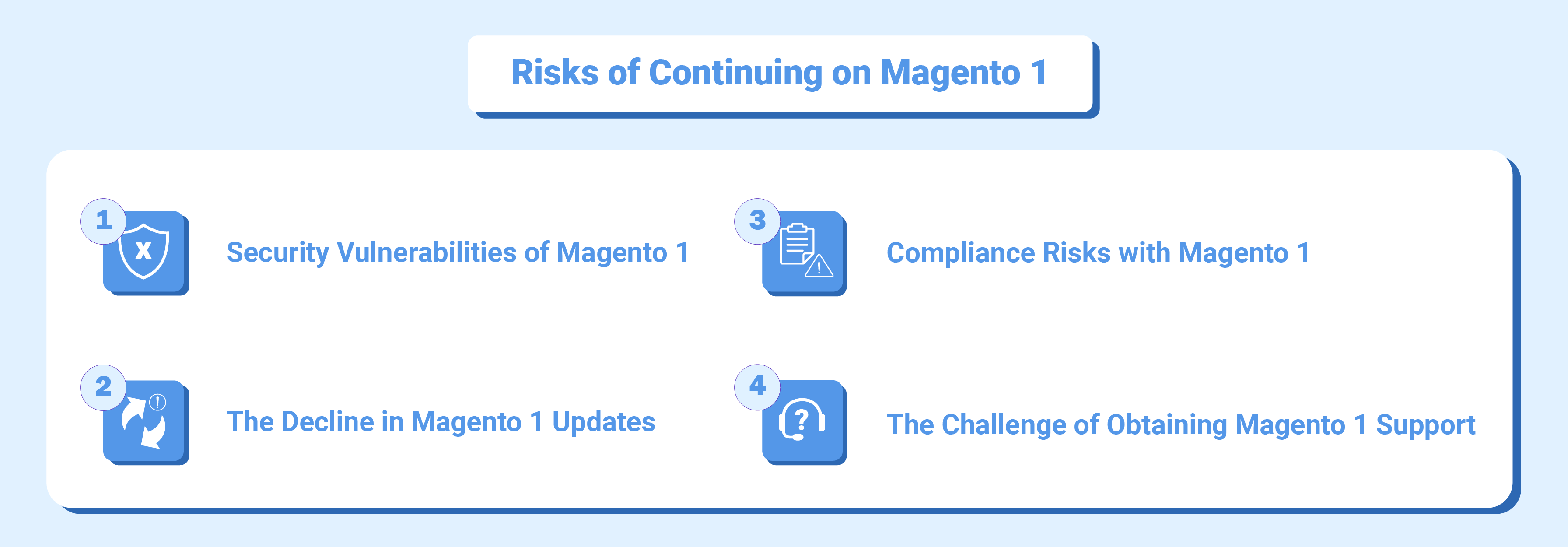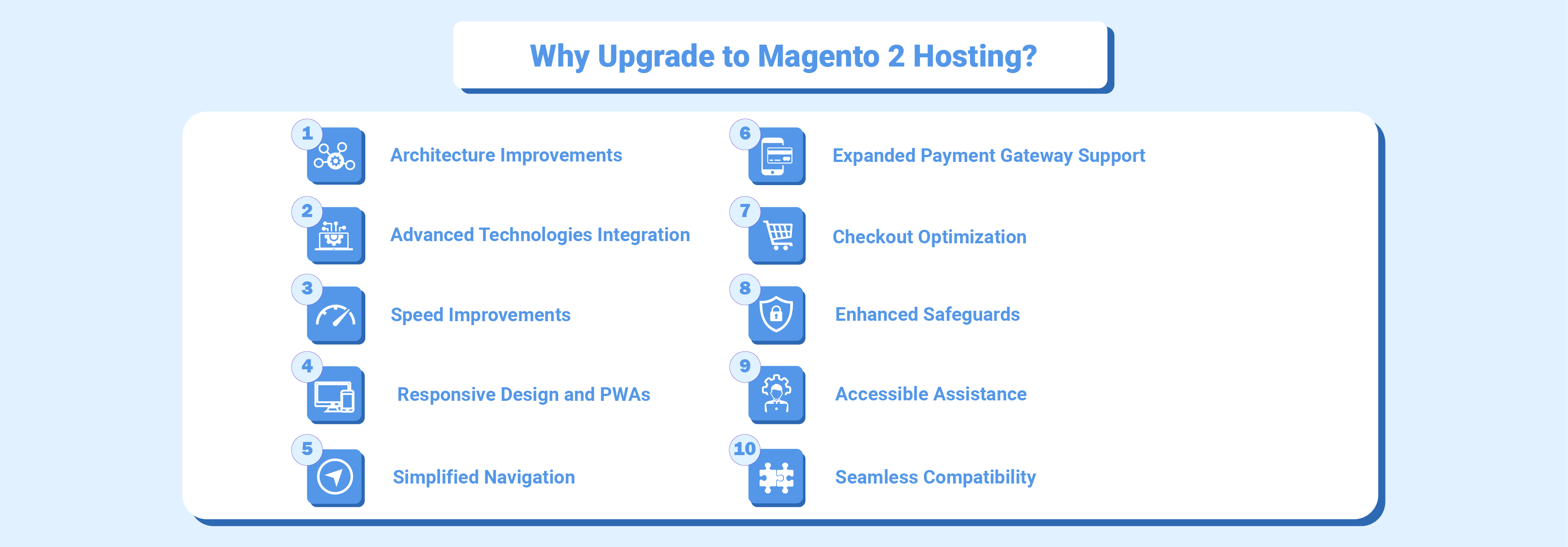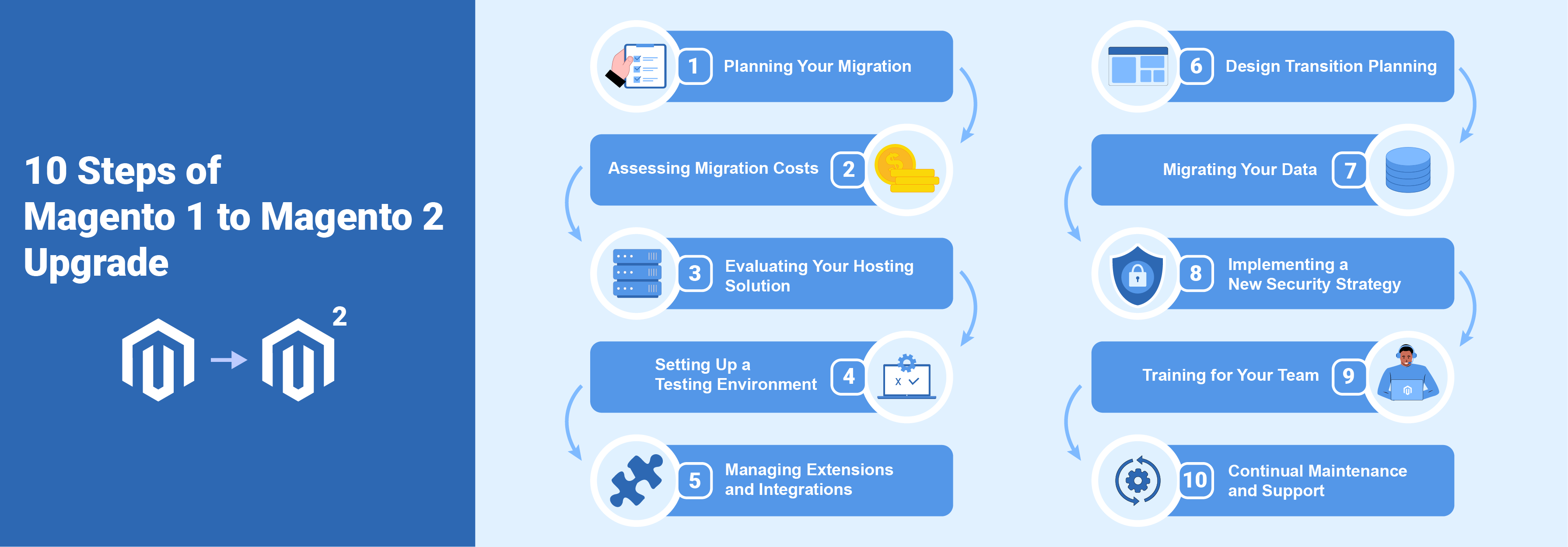
Best Magento 1 Hosting Practices for a Smooth Upgrade to Magento 2
Attention Magento 1 hosting users! The clock is ticking, and your eCommerce platform has approached its end of life. Is your online store prepared for the change? Upgrade to the feature-rich and performance-driven Magento 2. In this article, we'll guide you through the process of migrating your store to Magento 2. Ensure a seamless transition that will keep your business thriving.
Key Takeaways
-
Learn why upgrading from Magento 1 to Magento 2 is crucial for security and performance.
-
Understand the risks of staying on Magento 1, including security vulnerabilities and compliance issues.
-
Discover the benefits of Magento 2 hosting, such as improved speed, scalability, and security.
-
Explore the 10 steps in migrating from Magento 1 to Magento 2, including planning, data migration, and security strategies.
-
Gain insights into selecting the right hosting provider and understanding the importance of continual maintenance and support.
What is the Magento 1 EOL?

Magento 1 pioneered online shopping, allowing businesses to make special websites. However, Magento's official 'End of Life' (EOL) announcement in June 2020 marked the halt of new security patches and quality fixes for Magento 1. This exposes businesses to evolving cyber threats and may lead to legal compliance issues.
Risks of Continuing on Magento 1

1. Security Vulnerabilities of Magento 1
The end of life for Magento 1 brings compromised security. Developers now focus on Magento 2, leaving Magento 1 without new security patches. This part discusses the risk of cyber-attacks like DDoS, spam, phishing, and brute force attacks. Sites on Magento 1 are more vulnerable without updates. The section stresses the importance of migrating to secure platforms.
2. The Decline in Magento 1 Updates
Updates for Magento 1 have stopped. This includes both software and extensions. This section explains the impact on site performance and functionality. Magento 1 stores fall behind those on Magento 2.
It affects user experience and access to new web designs and features. The lack of updates means Magento 1 sites cannot grow or adapt. Businesses are urged to move to updated platforms.
3. Compliance Risks with Magento 1
Compliance with standards like PCI DSS is essential. This section looks at the compliance challenges for Magento 1 sites. Without security patches, these sites struggle to meet PCI DSS requirements. A statement from PayPal highlights the consequences of non-compliance. This can lead to fines and the loss of merchant services. The risks of staying on an unsupported platform are clear.
4. The Challenge of Obtaining Magento 1 Support
Support for Magento 1 is fading as the focus shifts to Magento 2. This segment discusses the difficulties in finding experts for maintenance and support. It becomes harder and potentially more expensive to find help for Magento 1 sites. The section emphasizes the need for migration. This ensures access to ongoing support and resources.
Why Upgrade to Magento 2 Hosting?

1. Architecture Improvements
Magento 2 is built on PHP7 and supports HTML5. It integrates new technologies like Magento NGINX and Redis. This foundation improves site optimization and customization. It supports advanced frameworks and databases, significantly improving over Magento 1.
2. Advanced Technologies Integration
Magento 2 includes technologies such as Varnish and Composer. These contribute to a robust and flexible platform. They improve performance and scalability.
3. Speed Improvements
Magento 2 uses its technology stack for faster loading times. Pages load 30% to 50% faster. The platform handles more orders and page views per hour. This improves user experience and operational efficiency.
4. Responsive Design and PWAs
Magento 2 focuses on mobile responsiveness. Websites perform well on smartphones. The platform supports progressive web apps (PWAs). This provides a better mobile shopping experience.
5. Simplified Navigation
The admin panel in Magento 2 is intuitive. It offers a clear overview of important metrics. It makes managing the site simpler. Users can easily customize their storefronts and manage products.
6. Expanded Payment Gateway Support
Magento 2 makes integrating payment gateways straightforward. It supports gateways like PayPal and Braintree without needing extra customizations. This enhances the Magento checkout experience.
7. Checkout Optimization
Magento 2 has an efficient checkout process. It reduces steps and simplifies selections for payment and shipping. This leads to smoother transactions for customers.
8. Enhanced Safeguards
Magento 2 focuses on security. It includes regular patches and built-in PCI compliance. These features protect against vulnerabilities. They offer a secure platform for e-commerce.
9. Accessible Assistance
Magento 2 offers robust customer support. This is unlike Magento 1. Users have access to help when they need it. This ensures smooth operations.
10. Seamless Compatibility
Magento 2 allows easier integration with third-party extensions. This compatibility makes expanding and customizing e-commerce functions easier.
10 Steps of Magento 1 to Magento 2 Upgrade

1. Planning Your Migration
Gather your development team and stakeholders to outline the migration process. This planning phase should detail data migration, site redesign, and extension needs.
It establishes a realistic timeline, as a full migration could span from three to six months based on the complexity of your Magento 1 site.
2. Assessing Migration Costs
The financial aspect of migration is significant, with site audit, design, and development being major expenses. The total cost varies with the complexity of your Magento 1 site and the required level of work.
3. Evaluating Your Hosting Solution
Magento's complexity demands a finely tuned-hosting environment. Transitioning to Magento 2 or another platform necessitates adjustments by your hosting provider to ensure optimal performance.
Upgrading your hosting infrastructure could enhance scalability, and security, and potentially reduce costs, with solutions like fully managed Magento Hosting from MGT-Commerce being a viable option.
4. Setting Up a Testing Environment
Creating a dedicated testing environment on a separate server is essential. It allows you to test the migration phases without affecting your live Magento 1 store. This step ensures that your operations remain uninterrupted during the transition.
You'll need Linux (Ubuntu or Debian), Apache/Nginx, PHP 7.4, MySQL/MariaDB, Elasticsearch 7.6.x, and PHP Composer to set up the tech stack.
5. Managing Extensions and Integrations
Audit your Magento 1 extensions to determine compatibility with Magento 2. Not all Magento 1 extensions will work on Magento 2, but updated versions may be available in the Magento Commerce Marketplace.
If necessary, your development team may need to create custom extensions. Testing these in your development environment is critical to ensure they are secure and functional.
6. Design Transition Planning
Themes from Magento 1 are incompatible with Magento 2, requiring a new template purchase or custom theme development.
Your design plan should retain the core features, functionality, and user experience of your Magento 1 site on the new Magento 2 platform.
7. Migrating Your Data
Using the Magento 2 Data Migration Tool is a necessary step. It helps transfer your store's configurations, customer data, products, orders, and settings.
Proper Magento data migration ensures the continuity and integrity of your online store during the transition to Magento 2. It is essential to thoroughly test the data migration process to ensure everything has been accurately transferred.
Magento 2 offers a Data Migration Tool for seamless migration. Prioritize creating a backup before migration. Steps include tool installation, configuration, settings migration, and data migration for product listings, orders, and customer info.
8. Implementing a New Security Strategy
With the transition to Magento 2, it is necessary to reassess your security strategy. As a newer platform, Magento 2 offers improved security features, including two-factor authentication and improved password encryption.
Additionally, regular security audits and updates should be a part of your maintenance plan to ensure the security of your online store and protect your customers' sensitive information.
9. Training for Your Team
Successful transition to Magento 2 also requires training for your team. As Magento 2 has a different interface and features, educating and familiarizing your team with the new platform is necessary.
This includes training on managing products, orders, and customers and understanding the new design and customization capabilities.
10. Continual Maintenance and Support
Once your transition to Magento 2 is complete, it is essential to have a plan in place for continual maintenance and support. This includes regular updates, security patches, and ongoing technical support for any issues that may arise.
By having a support plan in place, you can ensure the smooth operation of your online store and address any issues promptly.
FAQs
1. What should I consider when choosing a Magento hosting provider?
When choosing a Magento hosting provider, consider their experience with the ecommerce platform. Specifically, look for providers offering dedicated hosting or VPS hosting for Magento. Ensure they can handle the specific needs of a Magento website. Also, check if they offer a free SSL certificate.
2. What are the benefits of cloud hosting for Magento sites?
Cloud hosting provides scalability and reliability for Magento sites. It allows adjustments in resource usage based on your Magento store's traffic. Magento cloud hosting often includes managed hosting services. This means the hosting provider will handle server maintenance and security updates and optimize your Magento 2 hosting environment.
3. How does Magento 2 Hosting support ecommerce sites?
It offers specialized Magento web hosting solutions. They provide shared hosting, VPS plans, and dedicated server options. It is renowned for its swift performance and robust security measures. They also offer free Magento install options, making them a top choice for the best Magento hosting provider.
4. Why is a dedicated hosting service recommended for Magento enterprise hosting?
A dedicated hosting service offers exclusive server resources for your Magento site. It's perfect for high-traffic Magento enterprise hosting. This guarantees optimal performance, security, and scalability. This leads to a seamless customer shopping experience on your ecommerce platform.
5. Can I use a shared hosting plan for my Magento store?
While a shared hosting plan is the most cost-effective option, it might not offer the necessary resources and security for a burgeoning Magento store.
Magento requires substantial server resources to run smoothly. Shared hosting might not adequately support a growing Magento website.
6. What is Magento cloud web hosting, and how is it different from traditional web hosting?
Magento cloud web hosting is a hosting solution optimized for Magento sites. It offers scalable resources and managed services on a cloud-hosting platform.
Unlike traditional web hosting, Magento cloud hosting is designed to adapt to the fluctuating traffic of an ecommerce site. This ensures stability and performance.
7. What should I look for from Magento hosting services in a web hosting plan?
When evaluating Magento hosting services, consider a hosting plan with a dedicated server or VPS hosting options. Check for compatibility with Magento 2 and a free SSL certificate for data security.
Ask about Magento-specific support and if the hosting company provides managed hosting for technical maintenance and updates. Opting for the right Magento plans from a trusted web hosting provider ensures optimal performance and security for your Magento site.
Summary
Still using Magento 1? Don't let it hold your business back. Upgrade to Magento 2 for better security, performance, and growth. Here's what you need to do:
1. Understand the risks of staying on Magento 1
-
Increased vulnerability to cyber threats
-
Potential compliance issues
2. Explore the benefits of Magento 2
-
Improved architecture and technology integration
-
Faster page loading times for better user experience
3. Follow a comprehensive 10-step migration process
-
Plan thoroughly, migrate data, and implement security strategies
-
Train your team for a smooth transition
4. Choose the right hosting provider
-
Opt for scalable, high-performance managed Magento hosting
-
Reduce technical burdens and focus on growth
5. Prioritize continual maintenance and support
-
Stay on top of updates, security patches, and technical support
-
Keep your online store running smoothly
Don't let Magento 1's end of life be the end of your store. Get managed Magento hosting solutions for dedicated support.


